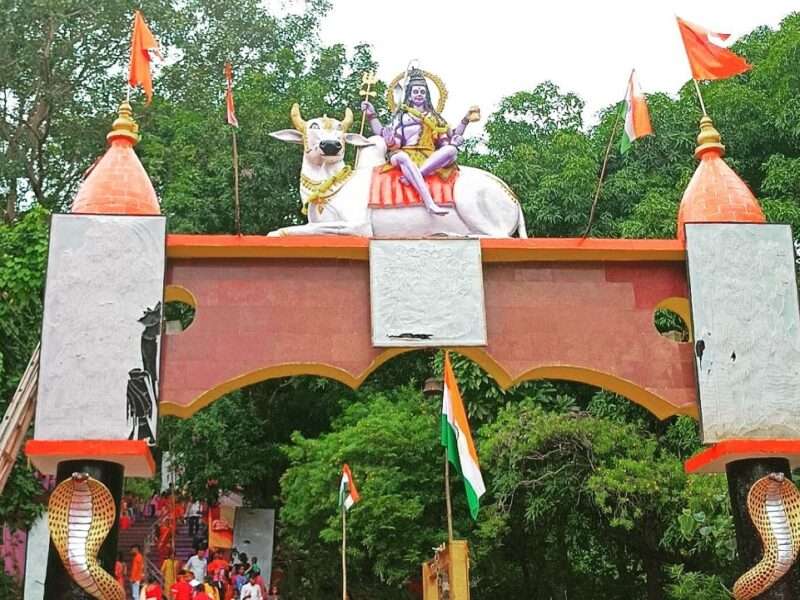Nestled amidst the verdant hills north of Barhait in Sahibganj district, the Shivgadi Dham Temple—also revered as Baba Gajeshwar Nath Temple—stands as a haven of spiritual serenity and rural mysticism. Often dubbed the “Mini Baba Dham” of Jharkhand, this cave shrine merges legends, natural wonders, and devotional fervor. This guide unfolds its origins, rituals, scenic beauty (including an adjacent waterfall), pilgrimage significance, visiting logistics, and the best time to experience its charm.
Table of Contents
Location & Natural Setting
Located approximately 6–8 km north of Barhait in Sahibganj, the temple occupies a mountain cave, reachable via a scenic climb. The approach path, lined with temple steps and shaded by native trees, culminates in a charming waterfall cascading near the entrance. Visitors often stop here, refreshed by the sight and sound of tumbling water before entering the sacred cave.
Legends & Mythical Origins
Legend of Gajasura
The temple’s central belief revolves around the demon Gajasura, referred to as Danvaraj Gajasur, who performed intense tapasya (penance) to please Lord Shiva. According to lore, pleased by his devotion, Shiva granted him a boon. Empowered, Gajasura wreaked havoc until celestial beings prayed for intervention. Shiva then vanquished him. Even at death, Gajasura praised Shiva—an act that compelled the deity to bless him and name the site Gajeshwar Nath Dham.
Architectural reminders of this tale include Nandi’s two-foot prints imprinted on a rock near the waterfall, said to be from the moment Nandi paused mid-mount while Shiva struck down Gajasura. The waterfall is locally called “Shivanga,” reinforcing its sanctified connection .
Mahabharata-Era Visit
Another tradition asserts that Lord Shiva appeared to Arjuna on this very hill during the Mahabharata era, conferring special sanctity to the place.
Temple Architecture & Natural Features
Shivgadi Dham consists of:
A cave sanctum housing the main Shivling installed by Gajasura. This lingam is unique: water drips continuously from the cave roof, a natural stalactite supply, keeping it perpetually abhishek. Pilgrims witness this unceasing divine shower as a living miracle.
An elegantly arched gateway adorned with Shiva and Ganesha idols, enhancing the spiritual atmosphere.
A serene waterfall near the cave, offering both natural beauty and ritual bathing before shrine entry—especially rejuvenating after the climb .
Rituals, Festivals & Devotional Practices
Devotees perform abhishek (ritual bathing) of the Shivling with water, milk, and bel leaves. The ongoing drip of water from the cave roof amplifies the sacredness.
Pilgrimage peaks during:
Shravan Maas (the monsoon month) – Mondays witness high footfall for Shivaratri Shivling ritual.
Mahashivratri – A grand event where thousands arrive to partake in night-long venerations, aartis, and group bhajans.
Locals and visitors also attend on Mondays, Pradosh Vrats, and Shiv Chaturdashi to receive blessings and participate in communal chanting.
Pilgrim Experience: Facilities & Customs
Staircase Approach: A decent-length climb through woodlands and rock-stairs requires moderate fitness.
Facilities: Basic amenities include toilets, modest shops offering prasadam (holy offerings), bells, and rudraksha malas.
Accommodation: No on-site lodging; nearest stays available in Barhait (around 6–8 km) or Sahibganj town (~30 km).
Guidelines: Proper attire recommended; footwear removal before entering cave. No large offerings are allowed—small symbols like devotees’ oil, flower garlands, or diyas are customary.
Travel Guide: How to Reach?
From Barhait:
By local transport (autos/taxis): ~6–8 km journey.
On foot/hiking: Road plus 20–30-minute stair ascent.
From Sahibganj:
Taxi or bus ride to Barhait followed by auto/taxi or walk.
Nearest major railway station: Sahibganj Junction (~30 km).
Closest airport: Ranchi (~220 km away); more accessible via Kolkata (~300 km) or Patna (~360 km).
Nearby Attractions & Extended Itinerary
Bongakocha Waterfall (~20 km from Barhait): A scenic addition to a pilgrimage-cum-nature retreat.
Moti Jharna Falls and Binduwashini Temple in Sahibganj: Combine natural and spiritual exploration.
Ganga Riverfront at Sahibganj: Popular for picnics and spiritual rituals.
Sidhu-Kanhu Fossils Park at Mandro: Geological-historical interest.
Best Time to Visit & Climate Insights
Shravan to Mahashivratri (July–March): Ideal due to festive seasons and temperate weather.
Monsoon (July–Sept): Watch for slippery paths yet lush foliage and full waterfall.
Summer (April–June): Suitable climate before peak heat; best for off-peak pilgrim experiences.
Why It’s Called “Mini Baba Dham”
Dedicated to Baba Gajeshwar Nath – Shiva worshipped in demon-transformed devotion.
Nicknamed “Second Baba Dham of Jharkhand” or “Mini Baba Dham” by locals and spiritual guides reflecting its sacred stature and regional reverence.
It echoes the scale and devotion mirror to larger Shrines like Baba Baidyanath in Deoghar but with rustic charm and intimacy.
Spiritual & Cultural Significance
Unique Lingam Phenomenon: Continuous water fed by the mountain—believed to be perpetual divine abhishek.
Mythological lineage: Connection to demon-saint Gajasura and Mahabharata character Arjuna enriches its religious narrative.
Community Centerpiece: Youths, local villagers, and priests maintain traditions; temples serve a communal hub during festivals.
Ecological Reverence: Steps, shade trees, waterfall, and cave contribute to a peaceful atmosphere encouraging reflection and devotion.
Tips for Travelers
Plan during Shravan/Mahashivratri for the most vibrant atmosphere.
Wear sturdy, non-slip shoes—monsoon paths can be slippery.
Carry water and snacks, as nearby choices may be limited.
Bring small offerings (flowers, fruits, oil) to participate in rituals respectfully.
Respect the natural site: carry back waste, leave no plastic, and maintain the sanctuary’s purity.
Read Also – Kashi Vishwanath Dham: Preserving History, Enriching Spirituality
Local Voices & Visitor Insights
Though mainstream travel reviews are limited, local coverage and social media buzz highlight it as a must-visit:
“The Shivgadi Temple is a Lord Shiva Temple situated 8 km north of Barhait… Must visit once!”
Travel vloggers describe the atmosphere as a fusion of nature and devotion, with instagram reels emphasizing scenic charm .
Conservation & Future Prospects
Discussions by local authorities and devotees include improving steps and safety, basic clean amenities, and offering guided information boards about the legends, geology, and rituals.
Maintaining the temple’s natural aesthetics and spiritual atmosphere, while responsibly growing tourism, is a community priority.

Conclusion
Shivgadi Dham Temple isn’t just a place of worship—it is an experiential blend of myth, natural beauty, and community devotion. The continuous waterfall-drip on the Shivling, the deep myth tied to Gajasura, and the natural cave atmosphere make it one of Jharkhand’s most intriguing pilgrimage destinations. Pilgrims and sightseers alike will find spiritual calm amid cascading water and mythic heritage.
For devotees tracing Shiva’s footprints or travelers seeking hidden sanctuaries, Shivgadi Dham stands as a testament to faith, folklore, and forested tranquility.
🗓️ Quick Facts
| Detail | Description |
|---|---|
| Name | Shivgadi Dham / Baba Gajeshwar Nath Temple |
| Location | 6–8 km N of Barhait, Sahibganj, Jharkhand |
| Legend | Shivling installed by Gajasura; Nandi’s rock prints; Arjuna’s darshan |
| Unique Feature | Constant natural drip on Shivling |
| Best Time to Visit | Monsoon (Shravan) & Mahashivratri |
| Nearby Attractions | Bongakocha falls, Binduwashini Temple, Moti Jharna |
| Access | Auto/taxi from Barhait; trek via steps through hill |
Embark on a journey beyond the ordinary temple tour—visit Shivgadi Dham to walk ancient steps, bath in sacred waters, and listen to cave whispers of Devotion.












